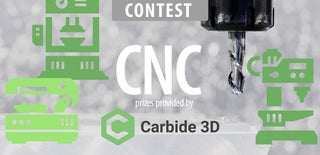Introduction: 3D Printing (Basics)
3D printing is becoming more and more popular. You may be looking to buy a 3D printer in your future so here are some basics for you.
Step 1: Research and Cost of a 3D Printer
Picking a printer may be the most important step in this tutorial. Printers come in a variety of sizes shapes and types. First lets start off with the cost. Printers range in prices down to 150 all the way up to several thousand. The number one thing to do before buy a printer is researching it. Don't just look on their website and see how great they promote it. Look on Instructables, Thingiverse and 3D hubs. Cost can effect the quality of part a company uses to make it but on the other hand spending 3000 dollars on a printer isn't required to get a good printer. The one im currently using is a printer from colido, DIY ColiDo 3d printer which costed me $265.
Step 2: PLA Vs ABS
PLA
PLA is more brittle and has a higher surface hardness. It is more prone to break when bent. Objects made from this material can be cut, filed, sanded, painted, and bonded using adhesives; treating them with acetone (for improving surface smoothness) is not possible. PLA is better suited for 3D printing beginners.
PLA is widely used in 3D printing, e.g. for household items, gadgets, and toys. It is better suited when flexibility is not your major requirement as it is more prone than ABS to break under pressure. On the other hand, it is biocompatible with the human body and can be used for objects that are worn on the skin.PLA is unsuitable for objects that are subject to heat: When exposed to 60ºC or more for some time, it loses its shape
ABS
ABS is printed at higher temperatures than PLA, which greatly reduces the danger of clogging or jamming the nozzle. Moreover, it requires less pressure when feeding the filament to the nozzle. As ABS tends to shrink when cooling, the printed parts may exhibit warping, and layers may crack or split (especially in high objects). To avoid this, using a heated bed is a must; an enclosed case improves print quality as it protects the printed object from breezes. Stringing and large retractions are usually no problem. Adhesion to the print bed is weaker than when using PLA – this can result in a number of printing problems. ABS is better suited for objects that need to withstand rough usage, hot environments, that need to be weather-proof, that may be dropped or have to be bendable. It can be used for parts that are subject to mechanical stress, for interlocking parts or pin-joints.
ABS is not considered to be a food-safe material: Especially when the material gets in contact with hot liquids or warm food, chemicals from the plastic will leach out into the liquid or food over time. To seal the surface, you need to post-process it using solvent polishing or painting that is food-save.
Further Explanation:
Step 3: Software
3D printing software has 3 main uses:
1. To convert STL files into G-Code ( Often called a slicer)
- One example is Cura.
2. 3d Modeling ( Uses to moke your own 3d models or modify ones that already exist )
- One of my favorite ones is 123 Design (This is by autodesk.Inc it is very simple to use and is extremely powerful)
3. Stl repair
This repairs models that may have errors ( one example is missing layers)
One example is Netfabb (This is what i do all of my repairs with).
Step 4: Calibrating
One of your first thing your going to have to do is calibrate your printer.
3D printers have a X, Y, Z axis which you will have to level. Here is a video on how to calibrate and level a 3d printer.
Step 5: Maintenance
Just like a car you 3d Printer needs maintenance. So here are some ways to help!
1. Keep the printer’s firmware up to date!
Oil your X, Y, and Z rods. I do this about once a month.
3.Periodically tighten nuts and bolts. Again, monthly. Periodically test and tighten belt tension.
4. Periodically test your filament tension. There’s a sweet spot to filament tension that’s a lot easier to set with a MK5 style plastruder than it was with a MK4 plastruder. Too tight and you’re putting extra strain on the extruder motor. Too loose and you’re not really getting the best extrusion possible. As plastic filament actually has a slight variation in its diameter, this is something I monitor whenever I am printing. .
5. Having a 3D printer means that if a part breaks or wears out you can actually replace it. Just accept the fact you’re going to bend, pop, snap, crackle, or pop a part. When that happens you’ll need to rig or hack a temporary solution while you print up a replacement part.
6. Floss extruder gear or use a toothpick to pop the plastic bits out of the gear’s teeth.
7. Check wire connections on any moving axes. The cable clips attaching motors, endstops, and various other bits to the XY stages can work themselves loose after time.
Step 6: Thanks
I really hope this instructable. I have learned a lot in the past year from 3d printing. I've taken apaprt my 3d printer many times i'm always learning so if you have anymore questions feel free to ask. Remeber to vote for me in the 3d printing contest!

Participated in the
CNC Contest 2016

Participated in the
Design Now: 3D Design Contest 2016











